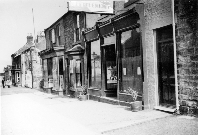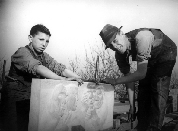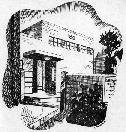|
|
|
 |

Spennymoor
Settlement: A Potted History

The
Spennymoor Settlement was established in 1930 with funds from the
Pilgrim Trust, with a resident warden W.G (Bill) Farrell, accompanied
by his wife, Ceridwen (Betty). Its objectives were:
"To
encourage tollerant neighbourliness and voluntary social service, and
give its members opportunities for increasing their knowledge, widening
their interests, and cultivating their creative powers in a friendly
atmosphere."

It
very quickly became known as the "Pitman's Academy". It was a time of
depression: unemployment was rife, Spennymoor was an impoverished
community, the future looked grim. Bill, with his deputy warden, Jack
Maddison, brought hope to a town of despair - providing the will and
means to fight back. They showed people new horizons and set them on
the path towards them. Things were done and, equally important,
exciting things were attempted. Much social and educational pioneering
work was accomplished at a time when the state and the economic system
were falling down on their jobs. A first priority was to give
unemployed miners something creative to do with their enforced leisure.
Symbolically, as it turned out, there was an early class on shoe
repairing. The cobblers mended many a worn-out leather sole; the
Settlement went on to mend hundreds of worn-out souls. There was a
pre-school childrens' play centre, using techniques not mastered
nationally for almost another thirty years. There was a Citizen's
Advice Bureau and a poor man's Lawyer Service, long before legal aid.
There was a branch of the County Library, manned by volunteers, years
before a purpose-built library was provided in the town.
 The
Everyman Theatre was built in 1939. Miners and their wives in the Drama
Group were discussing Stanislavski's "Method" two decades before it was
thrust onto the world. Socially significant plays were produced, with
every group - including Painting and Sketching, Womens' Sewing,
Woodworking, WEA Study Class members, and Boy Scouts Troop
contributing. Spennymoor was introduced to the works of Ibsen, Gorki,
Priestly, O'Casey, and others. A first night at the Everyman Theatre
production of Strindberg's Easter attracted the playwright's English
biographer, Elizabeth Sprigge, who marvelled at a mining community's
response to this sensitive work. The
Everyman Theatre was built in 1939. Miners and their wives in the Drama
Group were discussing Stanislavski's "Method" two decades before it was
thrust onto the world. Socially significant plays were produced, with
every group - including Painting and Sketching, Womens' Sewing,
Woodworking, WEA Study Class members, and Boy Scouts Troop
contributing. Spennymoor was introduced to the works of Ibsen, Gorki,
Priestly, O'Casey, and others. A first night at the Everyman Theatre
production of Strindberg's Easter attracted the playwright's English
biographer, Elizabeth Sprigge, who marvelled at a mining community's
response to this sensitive work.
At a time when University
education, even Sixth Form education, was the preserve of the
privileged few, adult scholarships galore were being won to Ruskin
Colledge Oxford, by Settlement Members. Many went on to win honours
degrees at Oxford and other universities. Now there are hundreds of
people scattered throughout the country, and the world, who owe The
Settlement a great debt of gratitude and to try perpetuate its values.
It was never the aim to produce men and women who thought and acted
exactly alike. Rather it was to produce men and women who know
themselves and something of the real beauty of Nature and Life - and in
knowing these things are able to appreciate their neighbours.
 The
actual theatre building was built in 1939 by out-of-work miners, to
provide a venue for the Everyman Theatre Company, which continues today
and has produced many plays over the years. A key physical feature of
the building is a stone sculpture on the front, which was created by
the famous sculptress Tisa Hess, otherwise known as Elizabeth, Countess
Von Der Schulenberg, who worked at the Settlement with the miners. Her
work has now been recognised in her home town in Germany. The
actual theatre building was built in 1939 by out-of-work miners, to
provide a venue for the Everyman Theatre Company, which continues today
and has produced many plays over the years. A key physical feature of
the building is a stone sculpture on the front, which was created by
the famous sculptress Tisa Hess, otherwise known as Elizabeth, Countess
Von Der Schulenberg, who worked at the Settlement with the miners. Her
work has now been recognised in her home town in Germany.
The
sculpture represents the faces of the comedy and tragedy masks, a well
known symbol of the dramatic arts, and the original models for it were
two local residents. The original sculpture has recently been copied
and the replica has been installed in its place, the original having
been mounted inside the Theatre for its preservation. This work has
been partially funded by Sedgefield Borough Council's Historic
Buildings Grant.
There has been a recent publicity campaign to trace the original stone
mason, who, along with his apprentice, installed the sculpture. Both
have been identified as local men who are now deceased. The campaign
has resulted in a great deal of interest in the Settlement and its
buildings as of local historical importance. Internally, the building
hosts a theatre stage and hall with sound and lighting equipment as
well as dressing rooms and toilets. This building is the Everyman
Theatre.
 There is also an
adjacent building which is owned by the Settlement Association. These
aspects combined; the history, the sculpture and the theatre that
highlights the Settlement as unique and of historical value, and the
building was granted Grade II Listed Building status in 2004.The
Settlement was known historically as the 'Pitman's Academy' and
nurtured the talents of people such as the writer Sid Chaplin and local
artists Norman Cornish, Herbert Dees, Tom McGuinness and Robert Heslop
to name but a few. There is also an
adjacent building which is owned by the Settlement Association. These
aspects combined; the history, the sculpture and the theatre that
highlights the Settlement as unique and of historical value, and the
building was granted Grade II Listed Building status in 2004.The
Settlement was known historically as the 'Pitman's Academy' and
nurtured the talents of people such as the writer Sid Chaplin and local
artists Norman Cornish, Herbert Dees, Tom McGuinness and Robert Heslop
to name but a few.
During the summer of 2008 a major refurbishment was carried out. The
theatre was re-opened to the public in September
2008.
The
first performance by the Everyman Theatre Company was “Alas Poor
Geoffrey” by Alistair Faulkner in February 2009.
A book detailing the history of the
Spennymoor Settlement has been produced by Robert McManners and Gillian
Wales. “Way To The Better” is available from our contact details at the
price of £12, with a few limited edition hardbacks available for £16.
Return to the top
|
 |